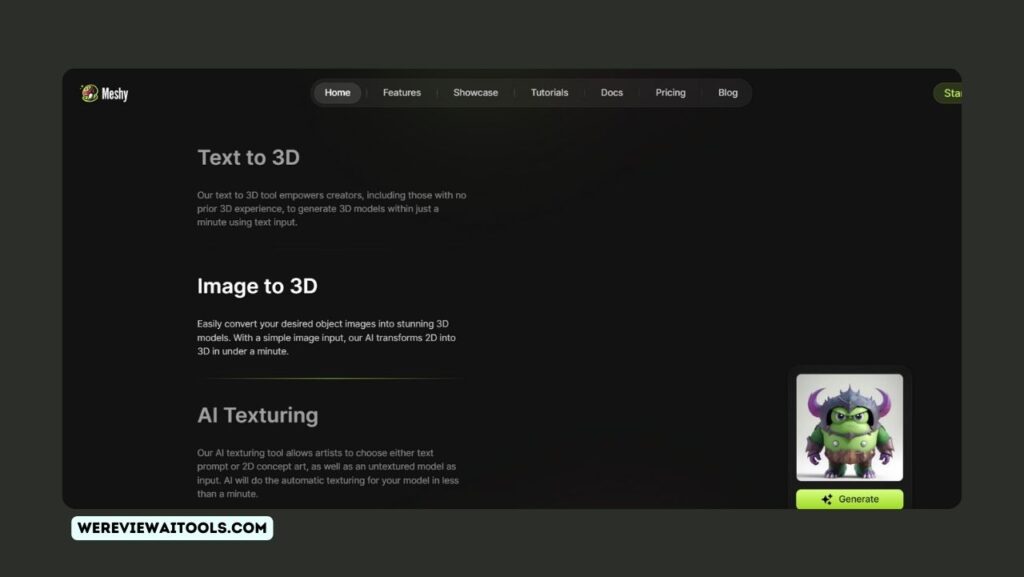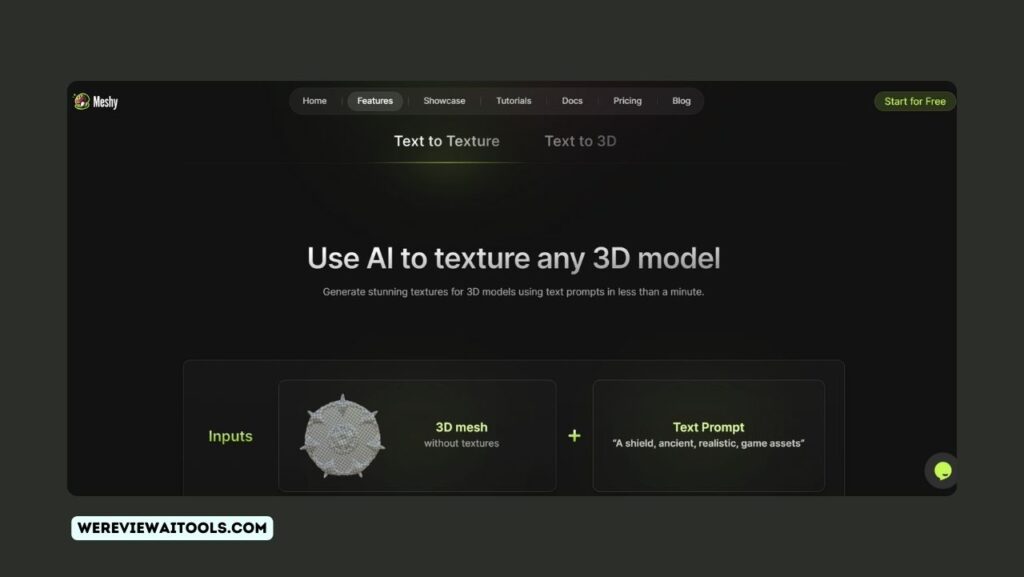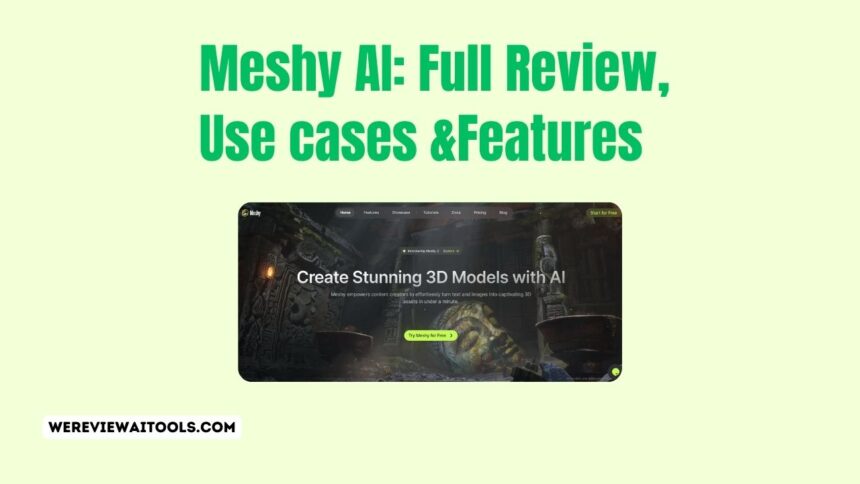Specialists have traditionally dominated the 3D production of content with technical expertise as well as expensive software. But, Meshy AI aims to open up this area to anyone to design 3D textures and models simple describing of their ideas or by using the existing 2D images? This is the goal of Meshy AI an innovative technology in the field, aiming to bring about a greater democratization of 3D media creation using the potential in artificial intelligence.
what is Meshy AI

Meshy AI is an 3D generative AI toolkit that aims to make 3D content creation easier and more accessible. It harnesses the capabilities of artificial intelligence to enable users to make high-quality 3D models and textures in two ways:
1. Text-to-3D: Imagine writing about the most fantastical creature or elegant gadget using words. Meshy immediately transforms your description into an actual 3D model. This opens up new possibilities for creators who do not have traditional 3D modeling skills, but possess an abundance of imagination.
2. Images-to-3D:Meshy will also inject new life into 2D images. Upload an image or photograph, or sketches drawn by hand then Meshy will transform it to a 3D model with texture and depth. This lets you transform existing ideas in a different dimension, or even use real-world objects within virtual worlds.
By eliminating the technical hurdles in the traditional 3D modelling, Meshy AI aims to open up 3D production of content and enable everyone to express their creativity within this area.
Read: How to Use Meshy AI?
How Meshy AI works
Meshy AI uses the technology of generative AI to convert images and text descriptions to 3D texture and models. While the exact details are complex the following is a brief description of the procedure:
1. Understanding Your Input:
- Text-to-3D When you input the text of your description, Meshy AI analyzes the words, and identifies the key elements and understands the general idea that you are trying to express in 3D.
- Image-to-3D Once you have uploaded an image, Meshy AI takes in visual information, such as shapes as well as colors and textures before converting it into data that the AI can use.
2. Generating the 3D Model:
- Utilizing Artificial Intelligence Models Meshy AI was trained using vast databases of current 3D models and their respective images or text descriptions. This type of training enables the AI to create an internal library of connections between visual or textual inputs, as well as those in 3D.
- Making the structure: Based on your input to the AI, the AI creates a 3D mesh that reflects the general shape and structure of your model.
- Add Textures and Details: Depending on the input (text or image) and the information available the AI fills the model with details such as color, surface textures, and other materials.
3. Refining and Finishing:
- Continuous learning: When Meshy AI creates new models, the system improves its learning and enhances its capabilities. The continuous learning process helps to improve the accuracy and depth of the next generation.
- Customer Feedback Feedback from users plays an important role in guiding the development of. Meshy AI integrates user comments and suggestions to enhance the functionality and quality of the models that are generated.
Key Features

Text-to-3D Think of describing a amazing creature or sleek gadget using words. Meshy instantly converts that description into an actual 3D model. This creates new possibilities for people who do not have traditional 3D modeling skills, but have an abundance of imagination.
Image-to-3D Meshy is also able to bring life to already existing 2D images. Upload an image photo, image, or sketches that you have drawn yourself then Meshy transforms it to a 3D model with texture and depth. This lets you make your existing concepts come alive in a completely new way or even use real-world objects within virtual worlds.
Text To Texture The new method of creating textures to 3D models. Simply write a description in the desired texture, then upload your model. Meshy will create an appropriate texture in just 3 minutes.
image to texture It was designed for designers and artists, without disrupting the original workflow. Meshy help you create textures using concepts art images and an initial model in just 10 minutes.
Multi Styles Options Select from 4 styles for your text-to-3D creations that include realistic, Cartoon, Low Poly, and Voxel. This covers a broad variety of tastes in art and encourages creative new directions.
Fast Generation: Meshy prioritizes efficiency. Previews are available in less than 25 seconds. You can also get refined results available in less than 5 minutes.
User-Friendly Interface Meshy is aware that AI should not be difficult to master. Its user interface is easy to use and designed to be easy to use, making it available to all creators.
Accessibility: A free plan with limited features allows users to experiment and experience the magic of AI-powered 3D creation before committing.
who benefits most from Meshy AI?
Imagine the possibility of transforming your ideas into breathtaking 3D models in just a few words or infusing life into existing sketches at the click of one button. Sounds like fantasy, right? It’s not. But that’s exactly what Meshy AI makes feasible, and it’s not just a tool for geeks. Although this AI-powered toolkit has potential for anyone but there are a handful of organizations that are poised to make it happen:
1. Non-technical creators: if you are a visionary but don’t have traditional 3D modeling abilities, Meshy AI empowers you to make your ideas come to life with simple text explanations or 2D images. This can be a boon to hobbyists, designers as well as educators and anyone with an imagination.
2.Rapid prototypers and iterators: For professionals like game developers, product designers, and visual effects artists, , Meshy AI will speed up workflows by speedily creating three-dimensional models as well as textures to help with preliminary concepts and prototypes. This could reduce time and effort while exploring a variety of design options.
3. Content creators who want an accessibility solution: Meshy AI democratizes 3D content creation through the opportunity to create content for free and with an easy-to-use interface. This allows freelance creators, educators and small-scale businesses to gain access top-quality 3D assets with no cost upfront or technical experience.
4. Artists who are exploring new media: Meshy AI offers unique opportunities for creative illustrators and artists. They can make use of their existing 2D art for the creation of 3D models, try different styles such as Voxel or cartoon and discover new possibilities for expression of digital art.
5. Businesses that focus on innovation: Companies that wish to make an impact with their visual presentations can utilize Meshy AI to develop distinctive 3D assets for promotional materials, product demonstrations or interactive experiences. This can increase the brand’s engagement as well as provide the most immersive experience to customers.
Applications of Meshy AI Across Industries
Meshy AI is much more than simply an 3D creation tool. It’s an innovation catalyst and blurring the line between reality and imagination. By translating descriptions, sketches and even old 2D images into breathtaking three-dimensional models as well as textures Meshy AI opens up new possibilities in various sectors. Let’s look at the ways in which this revolutionary technology is applied and the potential impact it could extend:
1. Design & Prototyping:
- product designers
Imagine visualizing your product’s designs in 3D. Meshy AI allows the designers of products to quickly prototype as well as iterate concepts with clients, thus reducing the time to develop and the cost.
- Interior designers, architects and architects
In the same way, architects and interior designers can also create virtual walksthroughs, investigate designs in a way that is interactive, and then present convincing designs, which are revolutionizing the process of designing.
2. Marketing & Advertising:
- Create eye-catching product demos and marketing : Generate unique 3D assets for interactive campaigns as well as posts on social networks.
- Create personalized user experiences Develop customized 3D designs based on the preferences of users to create targeted ads and engage.
- Create stunning visuals for presentations and virtual events.
3. Education & Training:
- Bring history, science, and abstract concepts to life: Create 3-D representations of historic figures complicated molecules or scientific phenomenons for interactive learning.
- Develop immersive simulators to train in: Develop realistic training scenarios for pilots, medical professionals or military personnel within the safety of a virtual world.
- Enhance accessibility by generating 3D models for students with visual impairments.
4. Arts & Entertainment:
- Create characters and environments for animation and film. Make use of Meshy AI’s various styles to produce unique visuals and speeds up the process of creating.
- Customize 3D-printed models as well as collectibles: Change 2D art or your personal photos into exclusive 3D models that can be used for souvenirs and gifts.
- Explore new ways of digital art. Play around with Meshy AI’s style options as well as the ability to convert text into 3D to create new artwork.
5. Personalization & Customization:
- Generate custom 3D-printed prosthetics and assistive device: Customize solutions based on the individual’s requirements and preferences.
- Make custom 3D-printed furniture or accessories for fashion: Express your individuality with unique, personal-designed items.
- Create personalized avatars to create virtual worlds and games.
Keep in mind that these are only an idea of what is possible. As Meshy AI grows its applications, they will surely increase, pushing the limits of innovation and creativity across a variety of fields.
Meshy AI: Challenges and Development Efforts
| Limitation/Challenge | User Feedback | Ongoing Development Efforts |
|---|---|---|
| Complexity and Accuracy | – Models lack intricate details and technical precision. – Difficulty capturing specific styles and nuances. | – Training algorithms on larger datasets for enhanced complexity. – Incorporating techniques for more accurate style and detail representation. |
| Style Control and Refinement | – Limited control over generated styles and textures. – Lack of depth in post-generation refinement tools. | – Exploring features for fine-tuning styles and textures. – Developing advanced editing tools for post-generation refinement. |
| Ethical Considerations | – Concerns about potential job displacement in creative fields. – Lack of transparency in AI development and decision-making. | – Engaging with creative community in open dialogue. – Exploring solutions to mitigate job displacement and promote responsible development. |
| Workflow Integration | – Difficulty integrating with existing 3D software workflows. – Incompatibility with certain data formats and tools. | – Pursuing seamless compatibility with popular 3D software. – Implementing standardized data formats and improving API access. |
Conclusion
In the end, the world of AI-powered 3D tool for creation is expanding, however Meshy AI is unique thanks to its unique characteristics. Through the process of transforming images and text to 3D models, as well as its user-friendly interface and a free plan it allows 3D creation available to all.
Although it’s not appropriate for models with complex designs or those who require advanced technological control, its flexibility and user-friendliness make it a great choice for educators, beginners or enthusiasts as well as creators.
As Meshy AI grows it’s focus on collaboration, user input and ethical issues sets the foundation for a future where everyone is able to make use of AI for bringing their unique ideas to reality in 3D.
Make sure that you choose the appropriate tool is dependent on your personal requirements and goals. Explore your options, unleash your imagination and discover the possibilities that lie in the fascinating realm of artificial intelligence-powered 3D creation!








